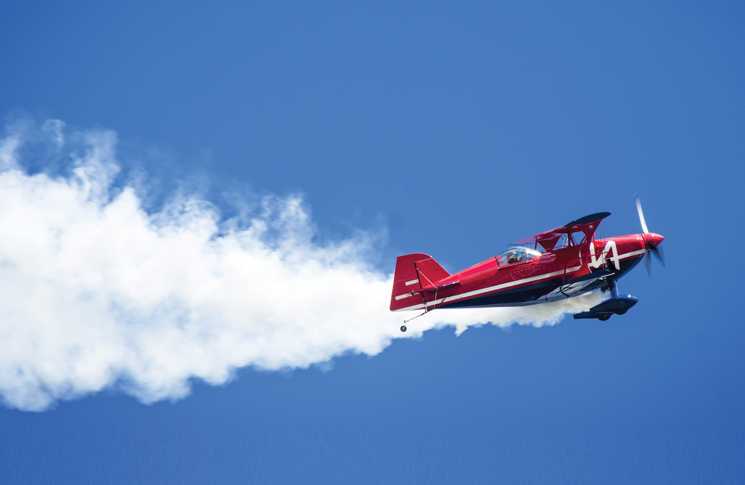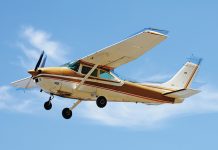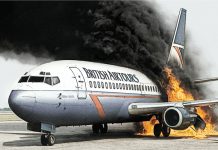When air shows take off again, will you have the knowledge and skills to get there by air? Kreisha Ballantyne has some important tips for safe travel and a stress-free visit
A ship is always safe at shore, but that’s not what it’s built for John Shedd, 1928
If general aviation were a cake, air shows would be the icing.
For many GA pilots, annual fly-ins are firm calendar dates: a weekend away, immersed in all things aviation, a chance to meet friends from other states, an opportunity to enrich our knowledge and learn new skills. But with COVID preventing many of us having our cake over the last year, never mind eating it, air shows were postponed in 2020 and pushed out to the end of 2021 or early 2022. This left many of us hungry for adventure, with our skills lacking the work-out required for high-carb activities.
Flying into busy, heavy-traffic airspace puts our piloting skills to the test. For those of us who haven’t done so since 2019 or earlier, the idea can seem a little daunting. However, safety is a matter of preparation, planning and a positive mindset – being well prepared is the key to a safe and successful arrival and departure at an air show.
Air show accommodation sells out faster than a Sunday morning bacon and egg roll.
Before the show
Book/check your aircraft
After deciding to fly into an event, make plans to secure your aircraft. If hiring, book well in advance and make sure the aircraft has no upcoming maintenance booked. If flying your own aircraft, check the maintenance release now and ensure you have plenty of hours ahead of the next annual, and no upcoming maintenance planned.
Check currency, recency and documentation
Make sure your medical is current and you meet recency requirements. Check you’re not only current but have the appropriate documents for your flight, such as pilot licence, aviation medical certificate and photo identification. As there’s always safety in numbers, consider taking along another pilot – or even an instructor if you’re rusty – as well as friends who can be great lookouts. If you haven’t flown in a while, try to get some hours well ahead of the event.
Book your tickets and accommodation
Don’t leave this to the last minute, as air show accommodation sells out faster than a Sunday morning bacon and egg roll. If camping, be sure to check the requirements about bringing your own equipment/hiring event equipment. If staying at a hotel or motel, ensure you have a means of getting between the accommodation and the airport.
A week to go
Study the guide
Most air shows and fly-ins issue a pilot guide well ahead of the event. This is a downloadable PDF containing specific information about the event:
- airfield features, including any additions for the show
- runway lengths and directions
- detailed images of the air show layout
- the airspace and any potential change
- radio frequencies, including UNICOM
- permitted arrival and departure times
- arrival procedures
- parking instructions, including marshalling
- fuel availability
- shuttle bus timetables if appropriate
- departure procedures.
Brush up on ground marshalling signals
Watch the video on the Tumut Aero Club website, which is a guide to both ICAO and CAO (Australian) standard marshalling signals.
Ensure your equipment is up-to-date
Check when the next nav-data release is for your aircraft panel navigation equipment and ensure you’re on the latest update. If an update occurs while you’re away, be certain to have the tools you need (portable wi-fi, USB sticks, laptop) to complete the update.
Check your EFB subscription is valid and you’re logged into the device without issue or, if using paper, make sure your maps, charts and ERSA are up-to-date.
Watch the weather
Australia is a wonderful place to fly in stable weather, but when it turns bad, our weather events can be significant. Access the BOM Knowledge Centre at bom.gov.au
Watch for trends because often, especially near the coast, departure may need to be brought forward a day if cold fronts, freezing conditions or low cloud cause an issue. If there’s been significant weather ahead of the show, do not be timid in calling ahead to obtain information about the airfield condition. Airport management’s numbers are listed in the ERSA.
The night before
Plan, plan and plan some more
If you haven’t already, begin your flight planning. Ensure your maps and charts are up to date and your device has plenty of storage, and credit on your sim card, if applicable.
Plan your flight being aware of any potential PRDs and ensuring you’ve selected the appropriate altitudes for your route. Complete your weight and balance and fuel calculations and “have a good look at the weather. Your EFB should have a detailed weather section where you can view synoptic charts, area briefings, satellite imagery, SIGWX charts, GPWT charts and winds aloft. Windy.com is a marvellous resource too (integrated in the two major Australian EFBs) as are BOM’s interactive weather maps. The major airport TAFs, which are valid for 30 hours, are also useful the day before.
Take a good look at the pilot guide for the show and visualise your arrival for each runway. Check you have the correct frequencies documented and, if using an EFB, import the PDF by opening it in your mail app and then tapping ‘open in AvPlan/Ozrunways’.
Ensure your aircraft is fuelled and checked over. Top up the oil and, if hangered, clean the windscreen. Pack your flight bag the night before and be sure you have a back-up device, a portable charger for your EFB, and any external devices you may use, such as portable GPS, ADS-B receiver and headsets with spare batteries. If using paper, check you have your charts, maps, ERSA, kneeboard, etc.
Self-care
Have an early night, avoid alcohol and any foods to which you’re sensitive. If you’re feeling in any way under the weather, consider a co-pilot position or even staying in bed the next day. Remember to pack any (CASA-approved) medication. Use the IMSAFE mnemonic to crosscheck your fitness to fly:
- illness
- medication
- stress
- alcohol
- fatigue
- emotion.
Even if the weather is perfect and the trip goes as smoothly as a fine chocolate spread, have an alternate plan.
On the day of the flight
Check the weather, NOTAMS and PRDs again. A complete weather briefing on the day includes applicable TAF, GAF, GPWT, SIGMET and AIRMET.
File a detailed domestic flight plan, not just a SARTIME. Flight plans can be filed and cancelled within your EFB. Ensure your fuel calculations add up and select an alternate if applicable. Have your frequencies ready and a script (written or in your head) ready for speaking to ATC and the UNICOM on arrival if appropriate.
Set your passengers up comfortably in the aircraft, making sure they have access to water. After conducting your external pre-flight inspection, take a step back from the aircraft to check there is nothing left on the ground, remove the chocks and any tie downs and set yourself up in the aircraft. Make sure all gear is secured and you have your EFB or maps and all other devices at hand.
Have a plan B
Even if the weather is perfect and the trip goes as smoothly as a fine chocolate spread, have an alternate plan. There are always circumstances beyond your control – you may arrive at the airport to find the runway closed or one of your passengers may require medical attention. Not everything can be planned, but hiccups can be dealt with by having an alternative.
With careful planning, a refreshing of skills, self-awareness and a plan B, we can safely sail (or fly) again into challenging conditions which sharpen our skills and reward us with some of the finest benefits GA has to offer.





